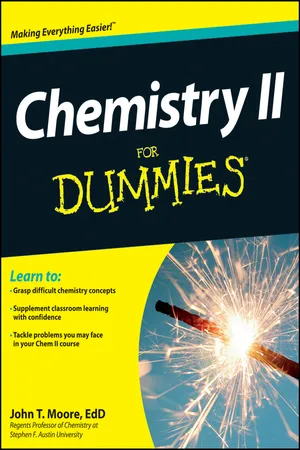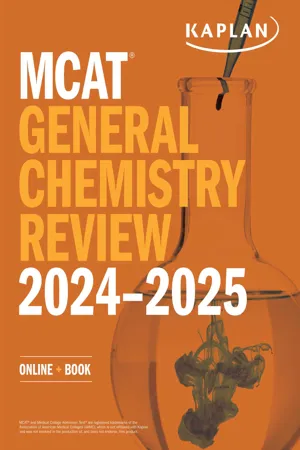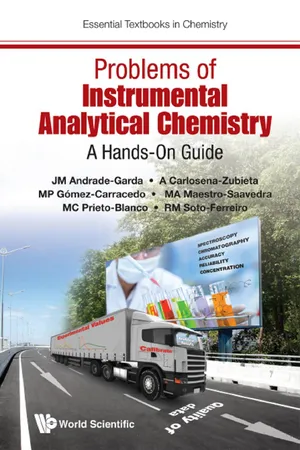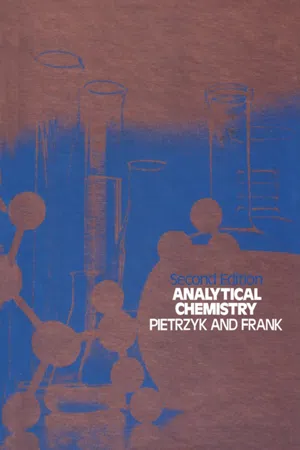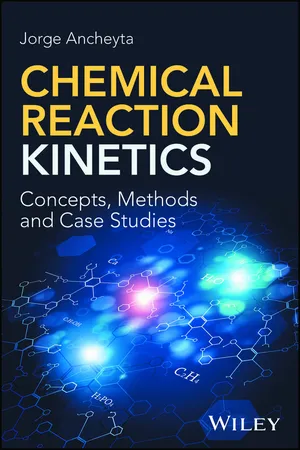Chemistry
Stoichiometric Calculations
Stoichiometric calculations involve using the balanced chemical equation to determine the quantitative relationships between reactants and products in a chemical reaction. These calculations are used to find the amount of reactants needed, the amount of products formed, and to predict the outcome of a reaction. Stoichiometric calculations are fundamental in understanding and predicting chemical reactions.
Written by Perlego with AI-assistance
Related key terms
Related key terms
1 of 4
Related key terms
1 of 3
8 Key excerpts on "Stoichiometric Calculations"
- eBook - ePub
- John T. Moore(Author)
- 2012(Publication Date)
- For Dummies(Publisher)
In stoichiometry, the mole concept is essential. The coefficients in the balanced equation are not only the number of individual atoms or molecules but also the number of moles. The ratio of the moles of one substance to another substance in the balanced chemical equation is called a stoichiometric ratio. With this ratio, you can convert from the moles of one substance in a balanced chemical equation to the moles of another substance. And if you can get moles, you can easily generate grams. In order to do any type of stoichiometry problem, you must have the balanced chemical equation. Calculating how many reactants and products Industrial chemists are interested in how much (grams, kilograms, tons, and so on) of a particular product can be formed with a certain amount (grams, kilograms, tons, and so on) of reactants in a certain chemical reaction. The mole concept allows these industrial chemists (and chemistry students) to do this - eBook - ePub
Principles of Chemical Engineering Processes
Material and Energy Balances, Second Edition
- Nayef Ghasem, Redhouane Henda(Authors)
- 2014(Publication Date)
- CRC Press(Publisher)
It is an equation that relates the relative number of molecules or moles of participants (reactants and products) in a chemical reaction. To be valid, the equation must be balanced. For example, the following stoichiometric equation is not balanced:The following equation is balanced because the number of atoms is the same on both sides of the equation (C, H, and O):C 2H 5OH +O 2→CO 2+H 2OC 2H 5OH + 3O 2→ 2CO 2+ 3H 2O5.1.2 Stoichiometric Coefficients
These are the values preceding each molecular species, i, in a balanced stoichiometric equation. Values are defined as positive for products and negative for reactants For the reaction,2SO 2+O 2→ 2SO 3v= − 2 ,SO 2v= − 1 ,O 2v= 2SO 35.1.3 Stoichiometric Ratio
It is the ratio of stoichiometric coefficients in a balanced stoichiometric equation Consider the oxidation of sulfur dioxide:2The following stoichiometric ratio is employed in solving material balance problems that involve this chemical reaction:SO 2+O 2→ 2SO 3Two reactants, A and B, are in stoichiometric proportion, if the ratio (moles of A present)/(moles of B present) equals their stoichiometric ratio determined from the stoichiometric equation2molSO 3generated1molO 2consumed5.1.4 Limiting Reactant
A reactant is limiting if it is present in less than its stoichiometric proportion relatively to every other reactant. It is the reactant that would be the first to be consumed completely, if the reaction were complete. In order to find the limiting reactant, you balance the stoichiometric equation and then take the ratio of the reactant amount (mole, flow rate) in the feed to reactant stoichiometric coefficient, that is,The ratio with the lowest value corresponds to the limiting reactant .=n ˙i ov i( molar flow rate of component i in the feed )( stoichiometric cofficient of component i )5.1.5 Excess Reactants
All reactants, other than the limiting species, are termed excess reactants. An excess reactant is not fully used up when the reaction is complete. The fractional excess is the ratio of the amount by which the feed exceeds stoichiometric requirements divided by the stoichiometric requirement The fractional excess of the reactant is the ratio of the excess to the stoichiometric requirement: - No longer available |Learn more
MCAT General Chemistry Review 2024-2025
Online + Book
- (Author)
- 2023(Publication Date)
- Kaplan Test Prep(Publisher)
equations are determined using the following steps in order:- Balancing the least common atoms
- Balancing the more common atoms (usually hydrogen and oxygen)
- Balancing charge, if necessary
Applications of Stoichiometry
- Balanced equations can be used to determine the limiting reagent, which is the reactant that will be consumed first in a chemical reaction.
- The other reactants present are termed excess reagents.
- Theoretical yield is the amount of product generated if all of the limiting reactant is consumed with no side reactions.
- Actual yield is typically lower than theoretical yield.
- Percent yield is calculated by dividing actual yield by theoretical yield and converting to a percentage.
Ions
- Like organic chemistry, ions in general chemistry have a system of nomenclature:
- Roman numerals are used for nonrepresentative elements to denote ionic charge.
- –ous endings can also be used to indicate lesser charge, while –ic endings indicate greater charge.
- All monatomic anions end in –ide.
- Oxyanions are given a suffix indicating how oxidized the central atom is. Those that contain a lesser amount of oxygen are given the suffix –ite, and those with a greater amount are given the suffix –ate.
- Oxyanion series with more than two members are given an additional level of nomenclature. The species with the fewest oxygens is given the prefix hypo–, and the species with the most oxygens is given the prefix per
- eBook - ePub
Problems of Instrumental Analytical Chemistry
A Hands-On Guide
- JM Andrade-Garda, A Carlosena-Zubieta;MP Gómez-Carracedo;MA Maestro-Saavedra;MC Prieto-BlancoRM Soto-Ferreiro(Authors)
- 2017(Publication Date)
- WSPC (EUROPE)(Publisher)
The calculations reflect the different stages of the analytical process and, so, the more complex the analytical procedures become, the more intertwined the required calculations will be. In general, calculations are not too complex although it is essential to understand what is going on chemically in each step of the analysis. This would allow students to establish the appropriate mathematical relationships between the various stages of the analytical process.To achieve satisfactory learning outcomes, you should be able to understand and justify every operation or calculation rather than only performing them mechanically, so that you yourself should be able to detect any gross error in the final solution. There is no single ‘magic’ formula to solve all exercises. Students have to learn problem-solving strategies and start developing some chemical intuition (’the chemical criterion’). This means that they must develop critical thinking skills to succeed in their professional lives.A fundamental starting point that falls outside the scope of this book is that the students should know how to formulate (and name) all the compounds involved in the exercises to correctly write and balance the chemical reactions. (S)He has to know how to perform the necessary basic Stoichiometric Calculations. Without this essential background, (s)he will not achieve satisfactory results in their degrees or, worse, they will fail as chemists. When the compounds mentioned into the numerical exercises are not of common use, their chemical structure will be shown. This will be particularly so in Chapter 6 .1.1.Relevant units and expressions of concentration
Initially, it is worth starting this chapter by presenting some basic recommendations. As a general rule, scientific notation must be used in order to avoid working with very large or very small numbers, being advisable to obtain a number between 1 and 10, and to express its magnitude through an exponent. Thus, large numbers have positive exponents and small numbers have negative exponents. - eBook - ePub
- Clyde Frank(Author)
- 2012(Publication Date)
- Academic Press(Publisher)
Chapter ThreeStoichiometry
Publisher Summary
All analytical procedures are based on either stoichiometric or nonstoichiometric methods. In a stoichiometric analytical procedure, the constituent whose amount is being measured undergoes a reaction with another substance. Nonstoichiometric methods are based on a measurement of a physical property that changes in proportion to the concentration of the desired constituent. Because many of these physical properties are easily measured with great accuracy, it is necessary to calibrate the procedure. The calibration empirically defines the relationship between the concentration of the desired constituent and the magnitude of the physical property for a given set of conditions. The chapter also explains that wet chemical methods—such as gravimetric and volumetric methods—and certain types of separation techniques are stoichiometric, while most instrumental methods, including optical and electrical techniques, are nonstoichiometric. The three most useful ways of expressing concentration in stoichiometric reactions are molarity, normality, and formality.INTRODUCTION
All analytical procedures are based on either stoichiometric or nonstoichiometric methods.In a stoichiometric analytical procedure the constituent whose amount is being measured undergoes a reaction with another substance or is made to decompose in accordance with a well-defined equation which can be written in terms of reactants (R) and products (P).(3–1)By measuring the amount of any one of the products (PC or PD ) or of the reagent used (RA is the desired constituent and RB is the reacting reagent) the amount of the desired constituent can be calculated by applying the laws of definite and combining proportions.Nonstoichiometric methods are just the opposite, in that exact, well-defined reactions cannot always be written. In most cases nonstoichiometric methods are based on a measurement of a physical property that changes in proportion to the concentration of the desired constituent. Since many of these physical properties are easily measured, often with great accuracy, it only becomes necessary to calibrate the procedure. The calibration empirically defines the relationship between the concentration of the desired constituent and the magnitude of the physical property for a given set of conditions. - eBook - ePub
- Jeffrey Gaffney, Nancy Marley(Authors)
- 2017(Publication Date)
- Elsevier(Publisher)
Chapter 4Chemical Equations and Mass Balance
Abstract
This chapter introduces stoichiometry beginning with the mole concept and using Avogadro’s number as a conversion factor between the number of moles and the number of fundamental units in a substance. Case studies are used to present the determination of the empirical and molecular formulas from experimental data. Methods for balancing chemical equations and determining the limiting reactant are covered. The difference between percent yield and atom economy in chemical reactions is discussed in terms of determining the most economical and greener processes, using the steel industry as a Case Study. The process controlling the aqueous solubility of ionic compounds and their influences on precipitation reactions is discussed. The determination of the concentration of aqueous solutions in molarity is also covered.Keywords
Mole; Empirical formula; Chemical equations; Stoichiometry; Limiting reactant; Percent yield; Spectator ions; Solubility; Precipitation reactions; MolarityOutline4.1The Mole4.2The Empirical Formula4.3Chemical Equations4.4Stoichiometry4.5Limiting Reactant and Percent Yield4.6Aqueous Solubility of Ionic Compounds4.7Precipitation Reactions in Aqueous Solution4.8Concentrations in Aqueous SolutionStudy QuestionsProblems4.1 The Mole
Since chemistry deals with the properties of individual atoms and molecules and how these atoms form chemical bonds to create compounds, it is important for chemists to determine the amount of a substance on the molecular scale. Although the common use of the term “amount of substance” used in Engineering may be interpreted as the weight (in grams) or the volume (in cm3 ) of a substance, in chemistry the amount of a substance is a measure of the number of fundamental particles, such as atoms, molecules, or ions that are present in a given mass of substance. The SI base unit for the amount of a substance is the mole . The exact definition of a mole is the mass of any substance, which contains the same number of fundamental units as there are atoms in exactly 12.000 g of 12 C. Carbon-12 was chosen to serve as the reference standard of the mole unit for the International System of Units since it was also chosen to serve as the reference standard for atomic mass and the atomic mass unit, as described in Chapter 1 - eBook - ePub
Chemical Reaction Kinetics
Concepts, Methods and Case Studies
- Jorge Ancheyta(Author)
- 2017(Publication Date)
- Wiley(Publisher)
1 Fundamentals of Chemical Reaction KineticsIn homogeneous reacting systems, all the reactants and products are in the same phase. If the reaction involves a catalyst, it is also in the same phase. To determine the rates of reaction, experimental information is needed, which is generated by using properly designed small‐scale reactors and experiments. These reaction rates cannot be directly measured, but they are obtained by means of experimental data such as the variation of time with respect to concentration of reactants or products, partial pressures and total pressure, among others.To obtain the kinetic expression that represents the studied reaction, there are various approaches that correlate the experimental data with the variables that affect them.When a reaction proceeds, one or more reactants can take part. It can be carried out in either liquid or gas phase, the reaction extent is measured by means of variations of reactants or product properties, or simply the reaction mechanisms are unknown. In any case, it is necessary before starting with the mathematical treatment of the experimental data to know the fundamentals of stoichiometry, thermodynamics and kinetics that will be further used for elucidating the specific mathematical expression for each type of reaction. This chapter is then devoted to introducing the readers to these topics.1.1 Concepts of Stoichiometry
1.1.1 Stoichiometric Number and Coefficient
A chemical reaction can be represented as follows:(1.1)where A, B, R and S are the chemical species, and a, b, r and s are their corresponding stoichiometric coefficients, which are the positive numbers before the chemical formula that balance the reaction.Eq. (1.1) - eBook - ePub
Watermaths
(Maths for Water and Wastewater Technologies)
- Simon Judd(Author)
- 2019(Publication Date)
- IWA Publishing(Publisher)
that all the reactants are completely converted to products). Whilst something of a simplification, this assumption allows the calculation of the amounts of reagents needed to carry out chemical processes. Since all chemical reactions proceed on a molecular level the relative amounts of chemicals involved can be calculated from the ratio of the number of molecules of each chemical species involved in the governing chemical equation. So, for example, in Equation 4.7 the stoichiometric ratio of the HCl, NaOH and NaCl is 1:1:1. This means that the corresponding weight ratio, according to Tables 4.1 and 4.2, is 36.5:40:58.5. On the other hand, for the precipitation reaction (where formation of a solid is denoted “↓“): (4.11) the stoichiometric ratio of hydroxide ions (OH −) to aluminium ions (Al 3+) in aluminium hydroxide is 3:1. This equation implies that dosing of water with aluminium salts influences the solution pH because HCl is generated by hydrolysis, i.e. reaction with water. Example: precipitation of aluminium hydroxide What mass of hydrochloric acid is generated by 2 kg of aluminium chloride and what mass of aluminium hydroxide is precipitated? From Equation 4.11, 1 mole of AlCl 3 generates 3 moles of HCl and 1 mole of Al(OH) 3. From Table 4.1, the molar weights are: So, for the reaction stoichiometry of 3 moles HCl to one mole AlCl 3 and Al(OH) 3 : A fundamental principle of chemistry is that the products and reactants of a chemical equation are in perfect balance: there is no net gain of either material or electrical charge. The balance in charge arises from the redox principle, which states that oxidation of one species of a chemical reaction must necessarily give rise to reduction of another
Index pages curate the most relevant extracts from our library of academic textbooks. They’ve been created using an in-house natural language model (NLM), each adding context and meaning to key research topics.
Explore more topic indexes
Explore more topic indexes
1 of 6
Explore more topic indexes
1 of 4
